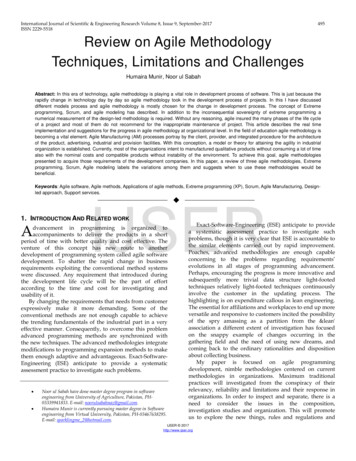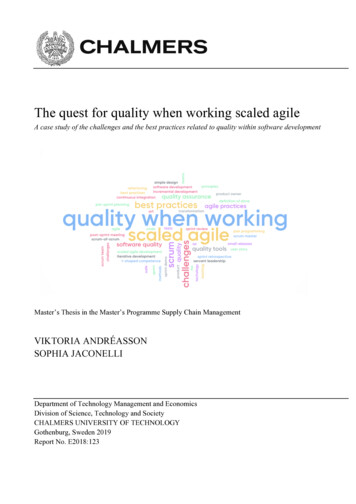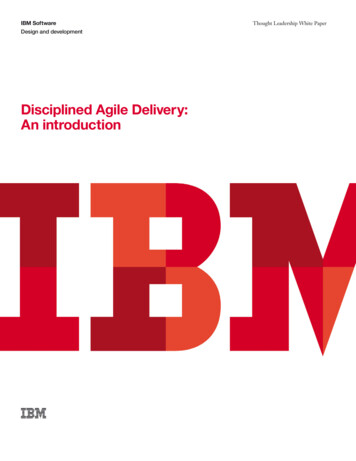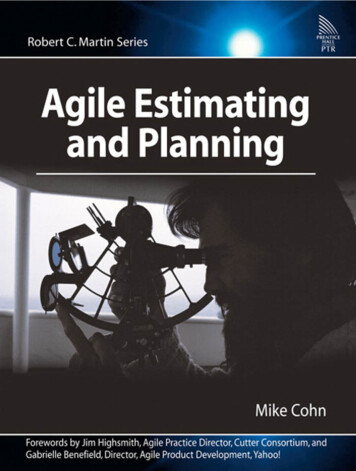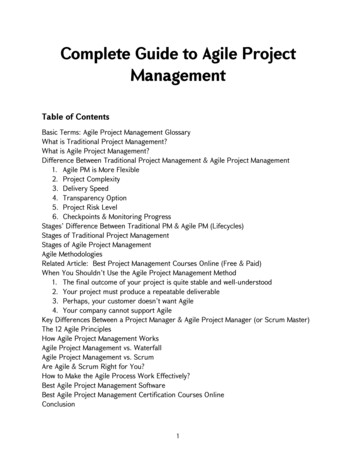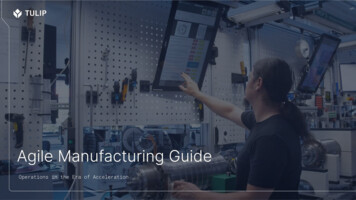
Transcription
Agile Manufacturing GuideOperations in the Era of Acceleration
Table of Contents1What is Agile Manufacturing?2History of Agile3Agile Manufacturing Principles4Features of Agile Organizations5Applications of Agile ManufacturingChapter OneChapter TwoChapter ThreeChapter FourChapter FiveProprietary & Confidential. Copyright 2021, Tulip Interfaces, Inc.2
Manufacturing is changing. Quickly. Call it Industry 4.0, the Fourth Industrial Revolution, or the new status quo, but thefact remains the same: manufacturing is experiencing an era of acceleration.To keep up, manufacturers need to adopt an approach that welcomes change.Increasingly, that approach has been Agile. Across industries and verticals, manufacturers apply Agile methods toaccess faster time to value and increase resilience in a time of disruption. Initially designed for software development,Agile allows manufacturers to harness a fast rate of change for competitive advantage.By emphasizing rapid iteration, operator augmentation, operational flexibility, and bottom-up innovation, AgileManufacturing enables a fast response to customer demands while empowering workers to innovate.This guide will introduce you to Agile Manufacturing. We’ll review history, dive deep into each of the principles, and giveconcrete tips on how to adopt this method of working on your shop floor.Proprietary & Confidential. Copyright 2021, Tulip Interfaces, Inc.3
1What is Agile Manufacturing?Fundamental Values of Agile Manufacturing
Agile Manufacturing is an approach to manufacturingthat leverages flexibility, bottom-up innovation andaugmentation in order to adapt, through an iterativeprocess, to changing conditions.Proprietary & Confidential. Copyright 2021, Tulip Interfaces, Inc.5
Four major shifts in the manufacturing landscape have made Agile methods necessary.12Proprietary & Confidential. Copyright 2021, Tulip Interfaces, Inc.6
34Proprietary & Confidential. Copyright 2021, Tulip Interfaces, Inc.7
1. Rapidly evolving environmentTechnology is driving significant changes in manufacturing. But technology is not the only moving part. Customers arealso evolving quickly. They now have higher standards. They expect greater product customization, faster delivery, andcheaper production. Regulations are changing as well, increasing in number and severity. Add to this the increasinglycomplex supply chains and questionable trade stability and you have an environment that demands flexibility. Just takethe most recent disruption of 2020 as an example. There was no way of preparing for such chaos besides being readyto respond to shifting demands.2. Constant technological developmentNew technologies appear every day, and manufacturing is getting its bearings in the digital age. Moving forward,manufacturers will feel the effects of new technologies in unexpected ways. According to a report published byMcKinsey, manufacturing will experience more disruptions in the next five years (2019 2024 than in the past twentyyears combined.Proprietary & Confidential. Copyright 2021, Tulip Interfaces, Inc.8
3. Workforce transformationLow unemployment rates and an enduring skills gap make it difficult for manufacturers to recruit skilled workers.Research by Deloitte shows that this skills gap may leave over two million manufacturing positions unfilled between2018 and 2028.By incorporating Agile, manufacturers can survive these shifts and remain competitive. But too often, “agile” is abuzzword, dissociated from its real meaning and principles. Let’s go back in time and recall the development of thenow-famous approach.4. More access to informationConnected factories produce data on an unprecedented scale. Data will enable leaps forward like predictivemaintenance and supply chain optimization. Companies will be able to act on real-time data at every level. Uppermanagement will be able to evaluate plant-level performance in real-time. Production managers will diagnose qualityissues before they reach downstream. And executives interested in contract manufacturer performance will gain newvisibility.Proprietary & Confidential. Copyright 2021, Tulip Interfaces, Inc.9
2History of AgileMoving away from the waterfall model to agile manifesto
The Agile movement was born in 2001, when seventeensoftware developers gathered in a ski lodge in Utah. They allhad at least one thing in common: a deep dissatisfactionwith the Waterfall model.The Waterfall model is a development method that is linearand sequential. Practitioners must complete each step ofproduction before they start the next. Though structuredand easy to follow, the Waterfall model has many pitfalls.Primarily, the Waterfall model discourages changing courseuntil the end of the development cycle. Because it privilegesforward progress, the waterfall model delays incorporatingfeedback, makes it challenging to adapt to changingrequirements, and slows production as engineers go to greatlengths to avoid mistakes.Proprietary & Confidential. Copyright 2021, Tulip Interfaces, Inc.11
Nestled in the Rocky Mountains, the software developers started contemplating an alternative, flexible model. They puton paper what would become known as the Agile Manifesto. Outlining four values and twelve principles, themanifesto would revolutionize the software engineering industry, and business as a whole.Some key takeaways from the Agile Manifesto laid the groundfor the Agile Methodology. Organizations should highly value interactions betweenindividuals.They should strive to have an ongoing conversationwith customers.They should modify their product or service based oncustomer feedback.Teams should be self-organized.The Agile Methodology was quickly adopted by developmentteams around the world for its capacity to reduce the time lagbetween business needs and technological developments.Photo of some of the software engineers, during theirconference at Snowbird resort in Utah in February2001.Proprietary & Confidential. Copyright 2021, Tulip Interfaces, Inc.12
The Agile approach has proven its worth. It decreases costs and time to market. It also increases cross-functionalcollaboration, revenue growth, and customer satisfaction. Agile also mitigates risk because teams take multiplelow-stakes decisions rather than a big, high-stakes one. Regularly delivering small pieces of value reduces the risk thatthe final product doesn't meet customer needs.Proprietary & Confidential. Copyright 2021, Tulip Interfaces, Inc.13
3Agile Manufacturing PrinciplesWhat differentiates agile manufacturing?
The Lean and Agile approaches are both wildly popular. However, they should not be confused. On the one hand, LeanManufacturing is focused on increasing efficiency by reducing waste. On the other hand, Agile Manufacturing aims toincrease efficiency via flexible, parallel problem solving.While some of the ideas of Lean Manufacturing and Agile Manufacturing overlap, the fundamental principles aredifferent.Proprietary & Confidential. Copyright 2021, Tulip Interfaces, Inc.15
Key Principles of Agile Manufacturing1. Iterate FasterThe idea of delivering smaller pieces of value more frequently is central to Agile Manufacturing. Rather than attemptingto design a single, perfect product in one go, the objective is to rapidly produce multiple versions. Each iteration, withits flaws and strengths, reveals new insights that make it possible to improve the process. As the process improves,each new version of the product surpasses the previous.Why does this incremental, iterative method result in a superior result? Because process engineers deal with manyvariables. Iterations allow them to test different solutions, and gather data on individual variables. Without this data, it isdifficult to determine which changes are necessary at a given stage to optimize production.Proprietary & Confidential. Copyright 2021, Tulip Interfaces, Inc.16
2. FlexibilityAccording to McKinsey, “Volatility is rising and taking its toll. Whether from increasing fluctuations in demand, laborrates and input prices, or from disruptive events like natural disasters and financial crises, volatility has damaged supplychains, increased costs and eroded profits. [. Companies are increasingly recognizing that they must alter theirmanufacturing strategies in the face of rising volatility.”In order not to bend under external forces, manufacturing companies need to have flexible systems. Their internalstructure needs to be dynamic enough to rebound quickly from external disruptions. Agile manufacturers are awarethat environmental factors - economic, political, environmental, social, technological - require them to constantly stayon their toes. They make sure that every component of their system can grow organically and adapt to changes.Proprietary & Confidential. Copyright 2021, Tulip Interfaces, Inc.17
3. Bottom-UpFor decades, goals and directives have passed from the top of the organization, to the bottom. The top-down approachhas its advantages, such as the quick implementation of decisions taken by upper levels of a company. However, thiscomes at a cost. Employees at the bottom can feel disconnected and disengaged. Low engagement can discourageaccountability and innovation.Agile manufacturers favor a bottom-up approach, in which ideas and directives flow seamlessly between all layers ofthe company. With this approach, directors and managers give operators and shop floor workers a voice. AgileManufacturing supports the idea that those closest to manufacturing challenges understand them best. The moreoperators, engineers, managers, and business executives collaborate, the more effective operations will be as a whole.Collaboration across functions and seniority levels yields higher value products and processes.Proprietary & Confidential. Copyright 2021, Tulip Interfaces, Inc.18
Proprietary & Confidential. Copyright 2021, Tulip Interfaces, Inc.19
4. AugmentationAugmentation is best understood in contrast to automation. Automation consists of automating workers’ tasks - inother words, of replacing workers by machines. Augmentation, on the other hand, enhances workers’ capabilitiesthrough technology.For years, automation was considered the solution to high labor costs and human error in the factory. Yet automation isalso expensive, difficult to maintain, and inflexible.Agile manufacturing argues that humans will perform best if they have tools that enable them to evolve their work.From computer-vision assisted quality checks to error-proofing work instructions, Agile manufacturers use technologyto help their people do more work, better.Proprietary & Confidential. Copyright 2021, Tulip Interfaces, Inc.20
4Features of Agile OrganizationsThe characteristics of a successful agile operations
In order to successfully implement Agile Manufacturing, manufacturers need to apply its principles and encouragesome changes to their organization. These changes will vary depending on the organization’s size and structure, butsome underlying features are common to most successful Agile organizations.1. Culture and purposeAgile culture puts people at the center. Agile organizations are structured in a way that team members have ownershipover their work. Leaders in an Agile organization do not rule over their employees, but rather provide them with tools toachieve results on their own.These autonomous Agile teams are goal-oriented. After setting their goals and deciding how to achieve them, teamsare held accountable for their progress. Even if different teams work on different goals, there is an organization-widecohesion: all goals fit into a greater purpose. Agile organizations understand that purpose is essential to give meaningto the short-term goals that teams work hard to meet.Purpose also increases productivity: when employees work with a sense of purpose, they are more engaged andmotivated.Proprietary & Confidential. Copyright 2021, Tulip Interfaces, Inc.22
Agile organizations share their purpose with everyone so that every employee knows why they’re doing what they’redoing. A purpose-driven mindset fuels people and boosts motivation and engagement.2. Network of teamsTeams hold great importance in Agile organizations. Accountability, transparency and collaboration are crucial withinteams. Team members have clear roles, but they do not necessarily have a single role and roles can be shared amongmultiple people. The work environment should be open and safe. Finally, teams should be in touch with each other, sothat members can source knowledge and insights from other teams.3. Rapid cyclesThe “Iterate Faster” principle of Agile Manufacturing encourages teams to quickly go through multiple versions of aprocess or product. The ability to implement this principle is a core feature of successful Agile organizations.In order to iterate faster, Agile teams work on concrete goals over short, predetermined periods of time. Both the goalsand the timeframe are critical to agility.Proprietary & Confidential. Copyright 2021, Tulip Interfaces, Inc.23
Proprietary & Confidential. Copyright 2021, Tulip Interfaces, Inc.24
Goals should be realistic and measurable. Team members are held accountable for them. The timeframe should befairly short - on the order of weeks - to keep teams iterating quickly.4. TechnologyTechnology is essential to all of the cornerstones of Agile Manufacturing. Without the right technologies, it is impossiblefor companies to deliver value at a fast enough pace to keep up with customer demands and market fluctuations.Examples of enabling technologies include real-time communication and work management tools, to improve flow andorganization; hackathons, to swiftly push out new solutions and products; and interactive digital work instructions, toeasily keep employees’ skill sets up to date.But Agile isn’t about adopting solve-it-all technologies. Rather, it is about finding the right technologies to improve theirunique processes, workers, and products.Proprietary & Confidential. Copyright 2021, Tulip Interfaces, Inc.25
5Applications of AgileManufacturingExamples of enabling technologies in action
Manufacturers can bring agility to their organizations by adopting the right technologies.To iterate faster, Agile manufacturers turn to technologies that help them collect data. To become flexible, tools andsoftware that enable quick turnovers are essential. To follow a bottom-up approach, Agile manufacturers award theirworkers more trust and power. To augment their workers, they equip them with the proper tools and training.Let’s look at some examples of enabling technologies in action.Proprietary & Confidential. Copyright 2021, Tulip Interfaces, Inc.27
Using Digital Work Instructions to Amplify Training ProgramsDentsply is the world’s largest provider of dental solutions. Their implants division receives thousands of custom ordersevery day, and each requires a very specific kitting combination. Because of the high variability of their kitting process,associates need to complete six months of training and shadowing before they qualify to enter production.In order to minimize errors and train with greater accuracy, Dentsply turned paper-based work instructions intointeractive digital apps. This not only helped with the execution of the work, but also allowed the Senior ProcessEngineers to streamline new operator training.Following the detailed instructions in their Tulip apps, new operators now self-train and learn new skills much fasterthan before. As a result, the Senior Process Engineer was able to reduce new operator training times by 75%, while alsosupporting over a billion different kitting combinations in their operation. By equipping workers with the right workinstructions tool, Dentsply was able to lower training costs and reduce human errors to enhance workers’ capabilities.Proprietary & Confidential. Copyright 2021, Tulip Interfaces, Inc.28
Using Computer Vision to Augment OperatorsComputer vision systems can assist operators through a production process. These systems track the operator’smovements and inspect the product as it is being made. Based on ongoing context analysis of the manufacturingenvironment, the computer provides assistance and performs the relevant quality checks.The worldwide leader of cutting machine tool, DMG MORI augmented their assembly station using this exact computervision system and off-the-shelf Intel cameras.DMG MORI integrated Tulip’s Light Kit with Vision for guided Pick-to-Light operations. Unlike break beam sensors,Vision easily detects changes at each bin with a single camera so that operators can receive immediate feedback whenthey try to grab a component from the wrong bin.With computer vision, manufacturers can deliver a much greater array of products without sacrificing productivity orquality. When used to assist operators in line, computer vision systems can help fatigued workers detect defects, andprovide error proofing in complex assemblies where workers are prone to miss or mis-execute steps. With computervision assisting with cognitively taxing tasks, operators can have put greater focus on problem-solving and innovation.Proprietary & Confidential. Copyright 2021, Tulip Interfaces, Inc.29
Digitally Tracking Production Data to Increase Quality in High-Mix AssembliesMagic Tilt is a manufacturer of aluminum and galvanized steel trailers designed for saltwater applications. Since theyare a high-mix high-volume shop floor, they do not carry ‘standard’ products. Each trailer differs in size andconfiguration and the required parts can vary by order.As a result, when part orders or repairs would come in, team members had difficulty searching through hundreds ofpaper documents to find the exact specs for the trailer. They would need to either create 2 3 parts until they got itexactly right, or ask their customers to send in the exact measurements themselves.Since incorporating digital production tracking onto their shop floors, the warranty department at Magic Tilt can pulltrailer documentation, including associated images, the precise measurements of brackets, the color of the carpet, andthe length of the boards. Instead of guessing or asking their customers to measure their trailers, Magic Tilt is now ableto deliver replacement parts correctly the first time, which saves them on scrap and shipping costs.Proprietary & Confidential. Copyright 2021, Tulip Interfaces, Inc.30
Using Real-Time Data to Guide IterationA leader in high-end boat manufacturing, Nautique assembles 13 boats and 500 600 customized cushioned parts aday, with 90 operators and 400 workers across 36 assembly lines.Despite their size of operations, operators often lacked real-time visibility on the parts as they went from raw materialto finished goods. Process Engineers attempted to perform time studies and other analyses, but their manual collectionof data couldn’t keep up with the pace and demands of the operations. This was holding back the production lines fromiterating on their processes.By collecting real-time data through the Tulip app, Senior Process Engineers are now able to increase the productionvisibility through automatic data collection. In a matter of days, they were able to start conducting granular data suchas real-time cycle times. This data allowed them to identify operators above and below average target times, as well asassembly lines that need immediate attention or correction. With such information, Tulip can now provide real-timetargeted feedback to operators and make real-time data-driven decisions for resolving production bottlenecks.Proprietary & Confidential. Copyright 2021, Tulip Interfaces, Inc.31
Using 3D Printing to Prototype Faster3D printers have the potential to greatly accelerate designing and prototyping. Iterative cycles become shorter as newversions of products are tested in a fraction of the time. Indeed, new prototypes no longer need to be designed andmanufactured in a process that can take months. Rather, they are simply printed and tried immediately. Products arethus tested early and often, and improvements are made with each version. The result: optimal end products thatsatisfy customer demands.3D printing also makes mass customization realistic for manufacturers. For example, 3D printing is transforming thejewelry industry by allowing the rapid production of highly detailed, custom parts. 3D printing allows manufacturers tobe much more flexible to changing customer demands.Proprietary & Confidential. Copyright 2021, Tulip Interfaces, Inc.32
ConclusionAgile Manufacturing Overview
The Agile Methodology has been in the spotlight for almost two decades. 41% of the organizations surveyed byMcKinsey say their companies have fully implemented or are in the progress of implementing a company-wide Agiletransformation. However, it is only in recent years that technologies enabling agility in the manufacturing sector haveemerged. Now, there is promising potential for manufacturing companies to join the digital revolution and leave the pastbehind.Proprietary & Confidential. Copyright 2021, Tulip Interfaces, Inc.34
Tulip, the Frontline Operations Platform, is empowering the world’s leading manufacturers to improve the productivity of their teams, the quality of theiroutput, and the efficiency of their operations. With Tulip’s no-code platform, manufacturers can empower those closest to operations to digitally transformtheir shop floors and gain real-time visibility into the people, machines and processes involved in production—all in a matter of days.Request a demo at tulip.co.
The Agile movement was born in 2001, when seventeen software developers gathered in a ski lodge in Utah. They all had at least one thing in common: a deep dissatisfaction with the Waterfall model. The Waterfall model is a development method that is linear and sequential. Practitioners must complete each step of production before they start the .

